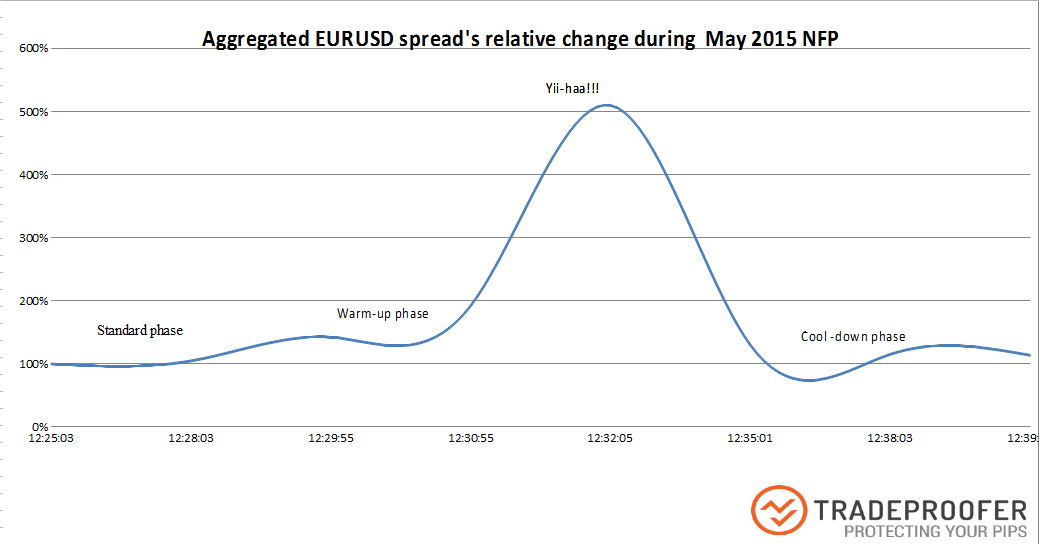Once per month, financial markets regularly take on the big spotlight. Every first Friday of the month, at 12.30 pm GMT, the US Bureau of Labor Statistics publishes the employment data, which gives a good glance on the state of the american economy. The US Non-Farm Payrolls release is the biggest fundamental piece of data the market gets regularly.

Besides our monthly report on the event, in this series of articles several of our dedicate contributors help us explaining its importance and impact on the FX trading. We also get from them valuable insights and tips to trade before and after the event.
Trade the Nonfarm Payrolls
Why is the NFP so relevant?
Wayne McDonell, Chief Currency Coach at FxBootcamp, gives a precise answer to the question in the first paragraphs of his article How To Prepare For and Trade the Employment Situation Report:
“This report is important because the US is the largest economy in the world and its currency (USD) is the global reserve currency. The many economies peg (tie) their currency's value to the reserve currency, many commodities such as gold and oil are priced in terms of the reserve currency and the local economy's debt is priced in terms of its own currency.
The Non-Farm Payroll report, because of its importance to the reserve currency, tends to move all markets: currencies, equities, treasuries, interest rates, and commodities. It does so immediately after the release of the economic data and sometimes dramatically.
A lot more skeptical on the benefits of trading the event, as you can read in its article Step aside the Non-Farm Payrolls release, Adrián Aquaro, President at Trader College, says its importance has decreased a little bit lately:
“Even if the impact has diminished gradually over time, the US Non-Farm Payroll still generates huge attention on the markets and it normally drives important monthly trends. Lately another event (the Fed Monetary Policy Meetings) has been driving similar attention, thanks mainly to the Interest Rates being at 0%.
Still, there is no denying to the impact of the data on the markets.
How does the NFP impact the USD?
The answer to this question can begin with a simple analogy. Better employment numbers (more payrolls added), good for the USD; worse numbers, bad for the buck. Kenny Fisher, Analyst at Forex Crunch, expands on that in his Tips on How to trade the Non-Farm Payrolls:
“A NFP which is stronger than the estimate (also known as the forecast) indicates that the labor market is stronger than what the markets expected, and the dollar often rises as a result. Why? Let's use a stock market analogy to answer this question. Just like a company's stock often rises after the company releases a strong financial report, so to the US dollar can be thought of as the "stock of the US economy". Thus, when the US releases a strong economic report, the "stock" (US dollar) often rises against other currencies (such as the euro, pound or yen) as a result.
Conversely, a weak NFP report indicates that the labor market is weaker than what the markets anticipated, and a weak reading can push the dollar lower against other currencies.
But there's much more to this question.
TIP
Kenny Fisher: “Keep current on financial news, especially on the US labor market and employment conditions. This will help you trade the NFP.
Measuring the impact that macroeconomic data such as the number of payrolls or the rate of unemployed people has on the markets is difficult and complex. Several methods, strategies and tips can be used. Our contributors share some of them in their reports:
Before the NFP release
The hours that precede the release of the employment report may be decisive. Kenny Fisher bewares us of the “high uncertainty", which “can lead to volatility in the forex markets, as traders and investors anxiously await the release". But, nonetheless, Fisher thinks that “the volatility often seen prior to a major event does present trading opportunities".
Trying to profit on that, Wayne McDonell sets up a technical range strategy (read it in his full article) before the release of the NFP data. In his words: “The goal is to overlap the average daily range with solid levels of support or resistance".
McDonell also does some modeling on related macroeconomical data to elaborate its fundamental analysis. Those include averages of past headline NFP numbers or Weekly Jobless Claims, ISM Industry Data reports or other employment reports as the ADP or the Challenger. That is key on the preparation of the trades to set up just after the release.
In contrast, Adrián Aquaro doesn't believe in trading before or after the event. He argues that “banks and press already known the information when released and therefore any trader has a disadvantage". Aquaro also defines the market moves in the minutes that follow the release as “completely unpredictable to individual traders".
Beware the spreads!
Viktor Eperjesy, Head of Business Development at Trade Proofer, is an expert in gathering information on the brokers' spreads, something every retail trader must take very carefully into account.
In his article, Eperjesy warns us about the divergence between “target spreads listed by brokers" and the actual spreads applied during a high volatility event as the Non-Farm Payroll. In his words:
“As we all know, forex brokers' information sheets listing "target spreads" are not something traders can rely on when they trade around important economic events, like non-farm payrolls. During these minutes spreads first fall apart and recover slowly afterwards as market calms down."
This evolution is way more explained with this very explicit graphic:

After the NFP release
The minutes just after the release tend to show big moves in the prices of the majors, but the volatility usually continues for several hours. Kenny Fisher believes in trading not only the actual release against the expectations, but also against the previous figure. Fisher sticks to the basics: “If NFP is higher than the estimate and/or the previous the dollar will likely move higher, but if lower, it will go down".
TIP
Wayne McDonell: “Trade the revision number. It is common to see 30% revisions. Especially on months when the headline number is “as expected", pay close attention the revised number. The market often trades that new information instead".
In a more advanced analysis, Wayne McDonell proposes another strategy for scalpers, those traders willing take quick trades and profit from short-term swings. This “continuation strategy", fully explained here, tries to trade “in the direction of the initial reaction to the news by the market".
Besides, McDonell also argues against “straddling the market" with “options style" strategies. FX Bootscamp's trading coach believes there are several problems with this, such as potential whipsaws, wide spreads and slippage.
Final tip
As you may note, our experts have different point of views, techniques and feelings towards the Non-Farm Payrolls release. There isn't one only way to approach it. The strategy to trade (or not) the release every trader should take is finally something to their choice. We hope these different views shared here can help you to take your own one and succesfully manage your accounts when trading this very highly volatile macroeconomic event.
Information on these pages contains forward-looking statements that involve risks and uncertainties. Markets and instruments profiled on this page are for informational purposes only and should not in any way come across as a recommendation to buy or sell in these assets. You should do your own thorough research before making any investment decisions. FXStreet does not in any way guarantee that this information is free from mistakes, errors, or material misstatements. It also does not guarantee that this information is of a timely nature. Investing in Open Markets involves a great deal of risk, including the loss of all or a portion of your investment, as well as emotional distress. All risks, losses and costs associated with investing, including total loss of principal, are your responsibility. The views and opinions expressed in this article are those of the authors and do not necessarily reflect the official policy or position of FXStreet nor its advertisers. The author will not be held responsible for information that is found at the end of links posted on this page.
If not otherwise explicitly mentioned in the body of the article, at the time of writing, the author has no position in any stock mentioned in this article and no business relationship with any company mentioned. The author has not received compensation for writing this article, other than from FXStreet.
FXStreet and the author do not provide personalized recommendations. The author makes no representations as to the accuracy, completeness, or suitability of this information. FXStreet and the author will not be liable for any errors, omissions or any losses, injuries or damages arising from this information and its display or use. Errors and omissions excepted.
The author and FXStreet are not registered investment advisors and nothing in this article is intended to be investment advice.
Editors’ Picks

AUD/USD weighed down by China, tariffs
AUD/USD remained on the back foot, slipping back to the area of multi-year lows around 0.5950 on the back of mounting fears surrounding tariffs and their impact on the Chinese economy.

EUR/USD refocuses on 1.1000 amid tariffs jitters
EUR/USD reversed two daily pullbacks in a row an d managed to advance to the boundaries of the 1.1000 barrier on the back of fresh weakness hurting the US Dollar and persistent tariff fears.

Gold erases gains, back to the $2,980 zone
Gold prices now lose extra ground and slip back to the area of daily troughs near $2,980 mark per troy ounce following an unsuccesful attempt to maintain the trade above the critical $3,000 level earlier in the day.

RBNZ set for another interest rate cut amid trade tariff uncertainty
The Reserve Bank of New Zealand is on track to deliver a 25 basis point cut to the Official Cash Rate, bringing down the key policy rate from 3.75% to 3.50% following its April monetary policy meeting on Wednesday.

The Fed is looking at a hefty price level
We are still in thrall to tariffs, the faux-macro “data” driving markets. The WSJ editorial board advised other countries to take their tariffs to zero so that Trump’s “reciprocal” tariffs will have to be zero, too. Cute, but no cigar.
RECOMMENDED LESSONS
Making money in forex is easy if you know how the bankers trade!
Discover how to make money in forex is easy if you know how the bankers trade!
5 Forex News Events You Need To Know
In the fast moving world of currency markets, it is extremely important for new traders to know the list of important forex news...
Top 10 Chart Patterns Every Trader Should Know
Chart patterns are one of the most effective trading tools for a trader. They are pure price-action, and form on the basis of underlying buying and...
7 Ways to Avoid Forex Scams
The forex industry is recently seeing more and more scams. Here are 7 ways to avoid losing your money in such scams: Forex scams are becoming frequent. Michael Greenberg reports on luxurious expenses, including a submarine bought from the money taken from forex traders. Here’s another report of a forex fraud. So, how can we avoid falling in such forex scams?
What Are the 10 Fatal Mistakes Traders Make
Trading is exciting. Trading is hard. Trading is extremely hard. Some say that it takes more than 10,000 hours to master. Others believe that trading is the way to quick riches. They might be both wrong. What is important to know that no matter how experienced you are, mistakes will be part of the trading process.

The Best brokers to trade EUR/USD
SPONSORED Discover the top brokers for trading EUR/USD in 2025. Our list features brokers with competitive spreads, fast execution, and powerful platforms. Whether you're a beginner or an expert, find the right partner to navigate the dynamic Forex market.

